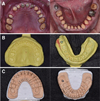This article has been
cited by other articles in ScienceCentral.
Abstract
Generalized severely worn dentition causes occlusal disharmony, esthetic problems, and temporomandibular joint disorders. In order to solve these problems, it is necessary to make a precise analysis of vertical dimension and treatment plans considering it. This case report demonstrates the complete mouth rehabilitation of a 58-year-old male patient with a lot of worn teeth by increasing vertical dimension. Provisional restorations were cemented and after 4 months of evaluation for patient's compliance, permanent prostheses were fabricated. With these treatments, functionally and esthetically satisfactory results were obtained.
Keywords: Worn dentition, Vertical dimension, Complete mouth rehabilitation
Figures and Tables
Fig. 1
Extraoral photograph before treatment. (A) Frontal view, (B) Frontal view smile, (C) Lateral view.

Fig. 2
Intraoral photograph before treatment. (A) Upper, (B) Right, (C) Frontal, (D) Left, (E) Lower.

Fig. 3
Panoramic radiograph before treatment.

Fig. 4
TMJ series before treatment. (A) Rt. close, (B) Rt. opening, (C) Lt. opening, (D) Lt. close.

Fig. 5
Determining vertical dimension of occlusion. (A) Diagnostic cast, (B) Willis method.

Fig. 6
Diagnostic wax-up with an increase of 3 mm of incisal guide pin.

Fig. 7
Provisional restoration. (A) Upper, (B) Right, (C) Frontal, (D) Left, (E) Lower.

Fig. 8
(A) Tooth preparation, (B) Final impression taking, (C) Die preparation.

Fig. 9
(A) Full contour wax-up, (B) Cut back, (C) Metal coping fabrication.

Fig. 10
Final prosthesis. (A) Upper, (B) Right, (C) Frontal, (D) Left, (E) Lower.

Fig. 11
Panoramic radiograph after treatment.

Fig. 12
TMJ series after treatment. (A) Rt. close, (B) Rt. opening, (C) Lt. opening, (D) Lt. close.

Fig. 13
Extraoral photograph after treatment. (A) Frontal view, (B) Frontal view smile, (C) Lateral view.





